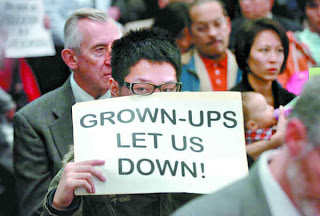Adults' confusion, missteps detailed
During a day of attacks Dec. 3, decisions were based on incomplete or inaccurate information.
On Dec. 3, as Asian students endured a daylong series of attacks at South Philadelphia High, the adults responsible for their safety were often confused or unsure how to respond.
The principal ordered a midmorning lockdown - designed to restrict student movement and move staffers to security posts - but some teachers weren't notified.
Asian students, who last year were allowed to go home early when trouble broke out, were first told they could leave, then instructed to return to class.
In the nurse's office, which housed injured Chinese students, including one with a broken nose, debate arose over who should call 911. Finally, the call was placed, not by school personnel but by a victim-witness counselor who had gone to the school.
Time after time Dec. 3, adults made decisions based on incomplete or inaccurate information, as documented in the school district's Feb. 23 report on the violence and in interviews for this article with teachers and students.
District officials said neither Superintendent Arlene Ackerman nor principal LaGreta Brown would be interviewed.
Michael Silverman, the regional superintendent who oversees South Philadelphia and other high schools, declined to discuss specific events that occurred Dec. 3. He said, however, that the violence had brought official scrutiny to how the school operated in a crisis.
"What we've done is really gone in and looked at all of their policies and procedures," Silverman said. "I think the school has really had an opportunity to reflect and to know how to improve going forward."
Ackerman, who ordered the inquiry that produced the report by retired federal Judge James T. Giles, has characterized it as "fair" and urged the public to move on from Dec. 3.
The report cites race as a factor in all the day's attacks on Asian students, carried out by large groups of mostly African American students. It blames the violence on rumors that followed an after-school confrontation the previous day, including one that Asian youths had beaten a disabled African American student.
One student described the terror that engulfed Asians that day. "We are so scared. We are speechless," said Bach Tong, a 16-year-old 10th grader.
That day, no one in the school leadership issued the equivalent of a "code red,"
The principal ordered a midmorning lockdown - designed to restrict student movement and move staffers to security posts - but some teachers weren't notified.
Asian students, who last year were allowed to go home early when trouble broke out, were first told they could leave, then instructed to return to class.
In the nurse's office, which housed injured Chinese students, including one with a broken nose, debate arose over who should call 911. Finally, the call was placed, not by school personnel but by a victim-witness counselor who had gone to the school.
Time after time Dec. 3, adults made decisions based on incomplete or inaccurate information, as documented in the school district's Feb. 23 report on the violence and in interviews for this article with teachers and students.
District officials said neither Superintendent Arlene Ackerman nor principal LaGreta Brown would be interviewed.
Michael Silverman, the regional superintendent who oversees South Philadelphia and other high schools, declined to discuss specific events that occurred Dec. 3. He said, however, that the violence had brought official scrutiny to how the school operated in a crisis.
"What we've done is really gone in and looked at all of their policies and procedures," Silverman said. "I think the school has really had an opportunity to reflect and to know how to improve going forward."
Ackerman, who ordered the inquiry that produced the report by retired federal Judge James T. Giles, has characterized it as "fair" and urged the public to move on from Dec. 3.
The report cites race as a factor in all the day's attacks on Asian students, carried out by large groups of mostly African American students. It blames the violence on rumors that followed an after-school confrontation the previous day, including one that Asian youths had beaten a disabled African American student.
One student described the terror that engulfed Asians that day. "We are so scared. We are speechless," said Bach Tong, a 16-year-old 10th grader.
That day, no one in the school leadership issued the equivalent of a "code red,"

